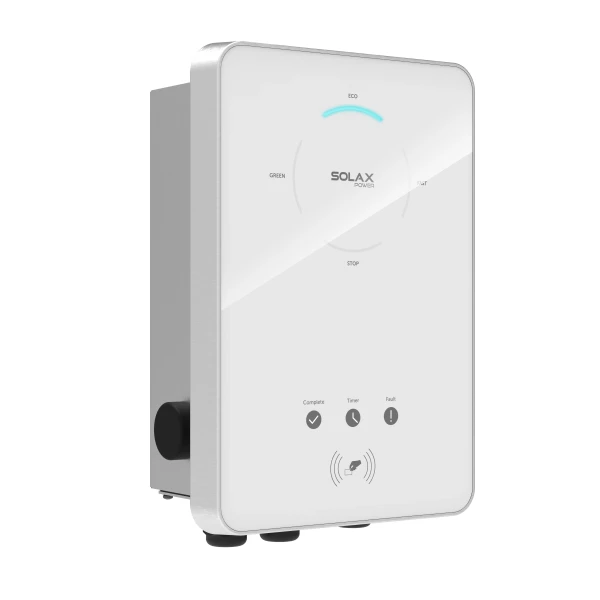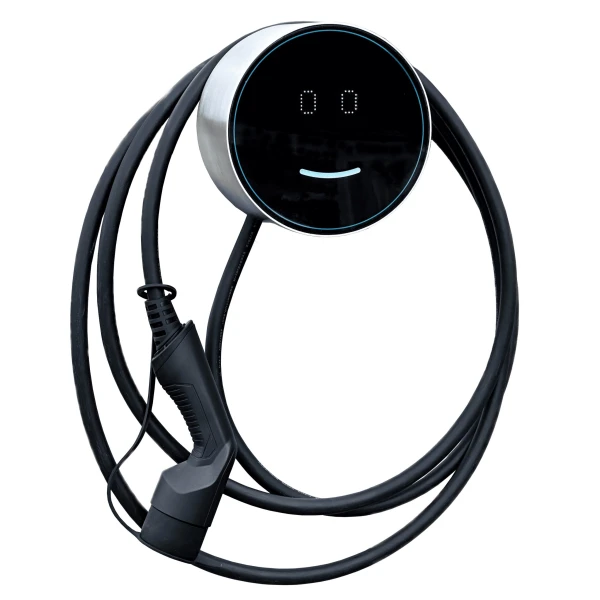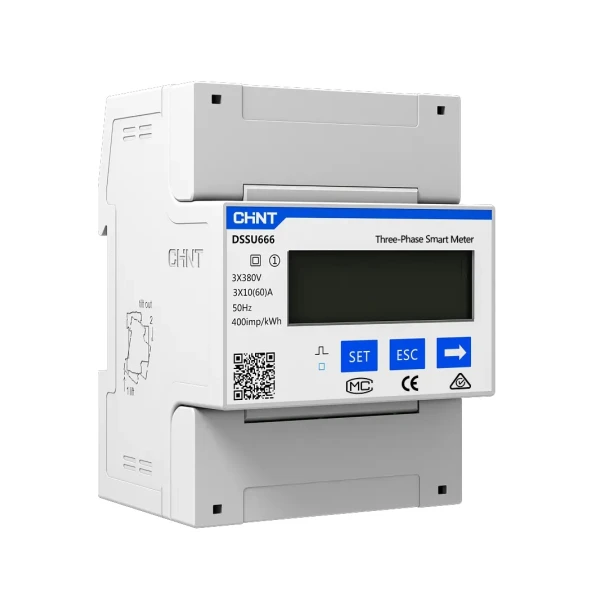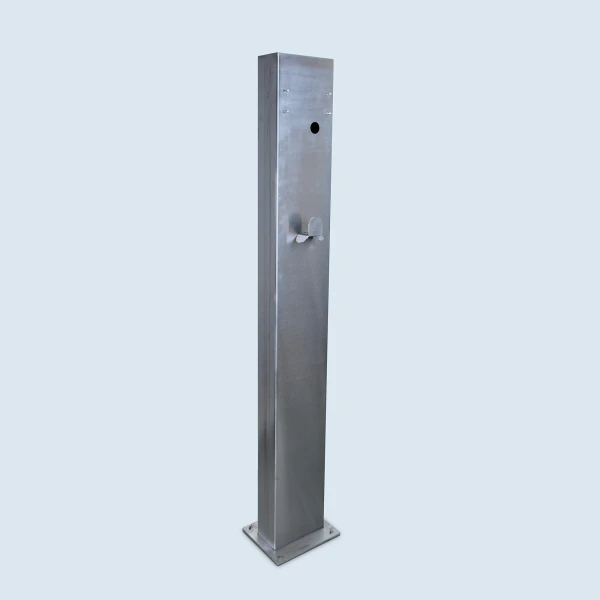EV chargers
Electric cars aren't just a trend, they're a conscious choice!
Today, electric car drivers are not only committed to an environmentally conscious future, but also pioneers of everyday mobility. To make this decision truly worthwhile – whether for a company fleet or your own garage – you need a reliable, high-performance, and safe wall charging infrastructure.
Our range includes single-phase and three-phase wall chargers with a power range of 7–22 kW, built-in Wi-Fi/Ethernet connectivity and RFID identification. Dynamic load and energy management allow the systems to intelligently control consumption, eliminating the need for costly network upgrades and preventing circuit breakers from tripping during peak hours. In addition to electric car charging, more and more people are interested in energy storage, as this allows for even more efficient use of green energy and further reduces grid consumption.
The impact- and weather-resistant, IP-rated housing is suitable not only for industrial sites, but also for use in front of family homes or as part of a solar carport, and can be seamlessly connected to a solar power system. This allows you to feed the green energy generated during the day directly into your car battery, reducing both grid consumption and your CO₂ footprint.
If you are a reseller, installer or wholesale partner, please register in our B2B webshopbefore purchasing your first EV charger ! Once your registration has been confirmed, you will be able to access our B2B webshop, where you will always find up-to-date information on prices, stock and current discounts. Once you have logged into the webshop, you can purchase EV chargers and place online orders quickly and easily.
Do you have any questions about our products?
As a B2B partner, please contact your designated sales representative, where our colleagues will be happy to assist you and answer any questions you may have about the EV charger you have selected.
You can also find a lot of useful information in the following frequently asked questions and answers:
How much power does the property's electrical network need to install an EV charger?
A modern AC wall charger can be scaled from 3.6 kW (1 × 16 A) up to 22 kW (3 × 32 A). The required fuse and cable cross-section are determined by the selected power level, so the network load and the available ampere rating must be assessed in the first step. If the required current exceeds the current connection value, a request must be submitted to the power supply company, which will specify the technical and economic conditions for expanding the network.
In an average family home, a 3 × 16 A (11 kW) system is sufficient to comfortably charge almost all purely electric passenger cars on a daily basis, but a 22 kW solution may be justified for fleets or models with large batteries.
What types of electric vehicles are these car chargers suitable for charging?
The range typically uses Mode 3, Type 2 sockets, which are now standard on all European battery electric (BEV) and plug-in hybrid (PHEV) cars. The chargers intelligently identify the maximum current draw of the connected vehicle's on-board charger and automatically adjust the power output in the 3.6–22 kW range. As the units are OCPP-enabled, the integration of future light commercial vehicles and models equipped for bidirectional (V2G) charging will not be an issue.
Where exactly should the charger be installed?
The safest and most user-friendly solution is to install the device on the wall of your garage or on the outdoor wall closest to your driveway. This allows the cable to reach the car's socket conveniently, while the housing protects the charger from strong sunlight and precipitation.
Indoor installation extends the service life of the device, but IP65 housings also work well outdoors – the key is stable, vibration-free mounting and avoiding mechanical damage. It is advisable to choose an installation height of between 0.7 and 1.2 meters so that the connection can be made with a single movement, even in cars equipped with parking sensors.
Is grounding or a separate circuit breaker required for the installation of electric car chargers?
Yes. For standard installation, a TN-C-S or TT grounding system and fault current protection are required. A 30 mA type A or F RCD is sufficient for alternating current leakage, but due to DC leakage, a type B (or type A + 6 mA DC sensor) circuit breaker must be installed in accordance with MSZ EN 61851-1, especially for higher power or multiple charging points.
The cross-section of the earthing conductor must be selected based on the size of the circuit breaker and the cable length; inadequate touch protection can cause electric shock and fire.
Is it possible to dynamically control the load of the EV charger?
Yes, most new wallboxes and background systems (e.g. Circontrol DLM or the load balancer built into the charger) are capable of continuously monitoring the current consumption of the house or site. When other high-consumption devices – air conditioning, heat pumps, industrial machines – start up, the software automatically reduces the charging current and increases it again when free capacity becomes available. This avoids oversized connection fees and tripping of the circuit breaker. The system can also distribute the available energy between multiple charging points and even prioritize photovoltaic production.
Is a separate power supply required for the operation of the accessories?
The Wi-Fi, Ethernet, RFID reader, and Modbus meter electronics are powered from the charger's main power cable, so no separate power outlet is required. Only the communication cables (LAN, RS-485, possibly CT current transformer cables) require an additional channel, but these operate at 24 V or data-level voltage. If you are connecting to an OCPP-based backend, a stable internet connection (LAN or 4G) is recommended, but most chargers do not require PoE power supply.
Is grounding or a separate circuit breaker required for the installation of electric car chargers?
Yes. For standard installation, a TN-C-S or TT grounding system and fault current protection are required. A 30 mA type A or F RCD is sufficient for alternating current leakage, but due to DC leakage, a type B (or type A + 6 mA DC sensor) circuit breaker must be installed in accordance with MSZ EN 61851-1, especially for higher power or multiple charging points. The cross-section of the earthing conductor must be selected based on the size of the circuit breaker and the cable length; inadequate touch protection can cause electric shock and fire.
Is it possible to dynamically control the load of the EV charger?
Yes, most new wallboxes and background systems (e.g., Circontrol DLM or load balancers built into the charger) are capable of continuously monitoring the current consumption of the house or site. When other high-consumption devices – air conditioning, heat pumps, industrial machines – start up, the software automatically reduces the charging current and increases it again when free capacity becomes available. This avoids oversized connection fees and tripping the circuit breaker. The system can also distribute the available energy between multiple charging points and even prioritize photovoltaic production.
I would like to expand the system later, e.g. with more cars, solar panels, and energy storage. Is this possible?
Most industrial and residential wallboxes are OCPP-compatible, so they can be easily connected to a multi-station network where load control is performed by central DLM software. The devices can also communicate with inverters and battery management systems via Modbus-RTU/TCP, allowing vehicle charging to be optimized based on the current output of the solar panels or the battery charge level. Expandability requires that the necessary protection and cabling reserves be prepared in the meter cabinet in advance, and it is advisable to choose an inverter that can be scaled later on the panel or storage side.
What type of cover and surface should the electric car charger be installed on?
A flat, non-flammable, heavy-duty wall (solid brick, concrete, structural steel) is ideal for securing the wall bracket screws properly. For outdoor installation, care must be taken to ensure that snow or standing water does not accumulate on the wall of the house and that the cable is not stretched when the vehicle is parked or driven out. Wooden or plasterboard walls are only suitable after internal reinforcement, as the weight of the charger (up to 6-10 kg including the cable) can pull out the plugs over time.
Will electric car chargers need to be licensed or registered with the electricity supplier?
A 300 V/16 A single-phase portable EVSE does not usually need to be registered, but in the case of a permanently installed 32 A or three-phase wallbox, a network expansion request is mandatory. The distributor (MVM/E.ON) will provide technical and financial information, specifying the connection fee, the conditions for converting the meter and the deadlines.Once the conditions have been met, the electrical contractor will carry out the touch protection measurement report and, upon receipt of this, the distribution company's employee will replace the seal.
If you are also interested in how much it actually costs to charge an electric car, read our detailed blog article, which uses practical examples to illustrate the actual costs.
Opinions and recommendations from SOLARKIT experts
SOLARKIT experts unanimously agree that the EV chargers in our range fully meet modern requirements: their weatherproof, IP65-rated housing guarantees long-term outdoor operation, their integrated dynamic load balancing protects the grid from overload, and their compatibility with solar systems allows excess green energy to be fed directly into the car's battery. This makes them a safe, cost-effective and environmentally friendly charging solution for home, apartment buildings and businesses.








